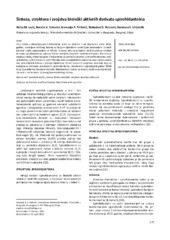Приказ основних података о документу
Synthesis, structure and properties of biological active spirohydantoin derivatives
| dc.creator | Lazić, Anita | |
| dc.creator | Valentić, Nataša | |
| dc.creator | Trišović, Nemanja | |
| dc.creator | Petrović, Slobodan | |
| dc.creator | Ušćumlić, Gordana | |
| dc.date.accessioned | 2021-03-10T13:02:06Z | |
| dc.date.available | 2021-03-10T13:02:06Z | |
| dc.date.issued | 2016 | |
| dc.identifier.issn | 0367-598X | |
| dc.identifier.uri | http://TechnoRep.tmf.bg.ac.rs/handle/123456789/3253 | |
| dc.description.abstract | Spirohidantoins represent an pharmacologically important class of heterocycles since many derivatives have been recognized that display interesting activities against a wide range of biological targets. First synthesis of cycloalkanespiro-5-hydantoins was performed by Bucherer and Lieb 1934 by the reaction of cycloalkanone, potassium cyanide and ammonium-carbonate at reflux in a mixture of ethanol and water. QSAR (Quantitative Structure-Activity Relationship) studies showed that a wide range of biological activities of spirohydantoin derivatives strongly depend upon their structure. This paper describes different methods of synthesis of spirohydantoin derivatives, their physico-chemical properties and biological activity. It emphasizes the importance of cycloalkanespiro-5-hydantoins with anticonvulsant, antiproliferative, antipsychotic, antimicrobial and antiinflammatory properties as well as their importance in the treatment of diabetes. Numerous spirohydantoin compounds exhibit physiological activity such as serotonin and fibrinogen antagonist, inhibitors of the glycine binding site of the NMDA receptor also, antagonist of leukocyte cell adhesion, acting as allosteric inhibitors of the protein-protein interactions. Some spirohydantoin derivatives have been identified as antitumor agents. Their activity depends on the substituent presented at position N-3 of the hydantoin ring and increases in order alkene gt ester gt ether. Besides that, compounds that contain two electron withdrawing groups (e.g., fluorine or chlorine) on the third and fourth position of the phenyl ring are better antitumor agents than compounds with a single electron withdrawing group. | en |
| dc.publisher | Savez hemijskih inženjera, Beograd | |
| dc.rights | openAccess | |
| dc.rights.uri | https://creativecommons.org/licenses/by-nc-nd/4.0/ | |
| dc.source | Hemijska industrija | |
| dc.subject | Spirohydantoins | en |
| dc.subject | Synthesis | en |
| dc.subject | Physicochemical properties | en |
| dc.subject | Biological activity | en |
| dc.title | Synthesis, structure and properties of biological active spirohydantoin derivatives | en |
| dc.type | article | |
| dc.rights.license | BY-NC-ND | |
| dc.citation.epage | 199 | |
| dc.citation.issue | 2 | |
| dc.citation.other | 70(2): 177-199 | |
| dc.citation.rank | M23 | |
| dc.citation.spage | 177 | |
| dc.citation.volume | 70 | |
| dc.identifier.doi | 10.2298/HEMIND150205025L | |
| dc.identifier.fulltext | http://TechnoRep.tmf.bg.ac.rs/bitstream/id/9422/0367-598X1500025L.pdf | |
| dc.identifier.scopus | 2-s2.0-84966687490 | |
| dc.identifier.wos | 000376274600009 | |
| dc.type.version | publishedVersion |

